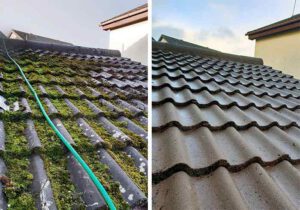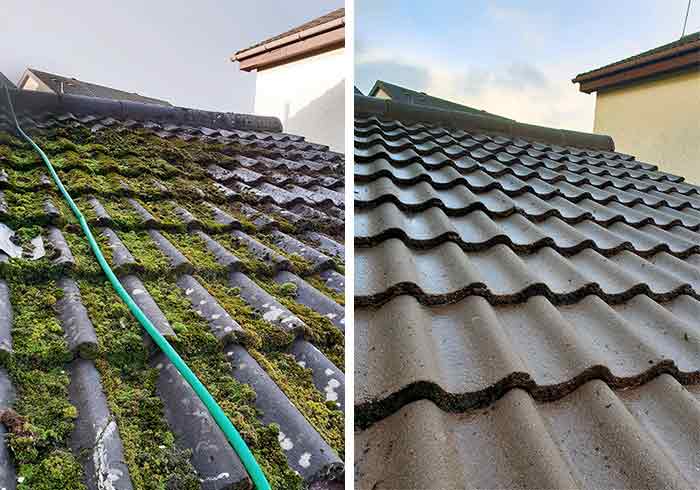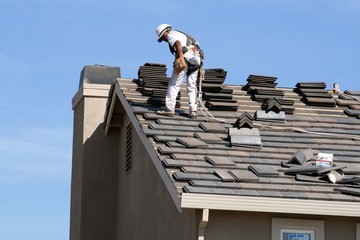A dirty roof attracts pests and lowers the value of your home. It also encourages mold to grow, causing health issues for you and your family.
Luckily, Roof Cleaning Summerville SC can get rid of these problems and help extend the lifespan of your roofing materials. Learn more about why and how often to clean your roof.
A dirty roof can be one of the biggest causes of water damage to a home. Moss, mildew, and dirt hold moisture against the shingles and roofing paper; when this happens, small cracks can become fissures that allow rain to creep under the shingles and into a home. In addition, clogged gutters cause water to back up and overflow onto the roof. This can also create holes in the shingles and roofing paper, leading to leaks and interior water damage.
A regular cleaning of the roof, along with the gutters and downspouts, can help prevent this type of water damage. A thorough cleaning will also reveal areas where the structure of the roof is damaged and needs repair, which can be easily repaired before significant water damage occurs.
Using a soft wash system, a biodegradable cleaning solution is sprayed on the roof and allowed to soak in, removing build-up debris. The low-pressure rinse won’t damage shingles or roofing materials and will also protect the environment by minimizing runoff into streams, ponds, and green spaces around the home.
In contrast, high-pressure power washing uses a pressure of up to 1,300 or 2,800 pounds per square inch (psi) that can strip away granules from older shingles and damage the roofing materials underneath. This can lead to premature wear and tear as well as voiding any warranty that may be on the roof. In addition, it can also erode the underlying concrete of a patio or swimming pool deck. The best way to avoid this damage is by using a soft wash system with a biodegradable cleaner. This will remove stains and kill algae or moss growth without damaging the roofing materials or the surrounding greenery.
Mold
Molds are fungi that can grow on a variety of things, including cellulose, which is found in plants and in many household materials such as wood and paper. They can be found both indoors and outdoors in all climates throughout the year. They grow by producing spores that float through the air and land on wet spots or surfaces. Once they begin growing, they digest whatever they are on and can destroy it. Molds also produce toxins and allergens that affect people. They can trigger asthma and irritate the eyes, nose, throat, and lungs.
Unlike mildew, which can be easily scrubbed away with a cleaning brush and store-bought mold killer, mold must be removed professionally. Molds can appear in various colors and have a velvety, fuzzy, or rough texture. They can have a musty odor. Mold can be infested with a wide range of bacteria that may or may not be harmful. They can also contain other organisms, such as yeast and algae, that may cause different health effects.
Some molds produce enzymes that degrade organic material such as leaves, animal carcasses, and rotting logs. They can also damage wooden structural components of buildings, food, and stored goods. They can even decompose the shingles and tiles on a roof and cause them to crack and crumble.
Molds that survive on a roof can enter a home through the attic or walls. They can also cause damage by attracting pests such as birds. Their sharp talons can tear shingles and make holes. They can also carry debris such as twigs and nesting materials to the interior of the house, which creates an unpleasant smell. In addition, if the shingles are damaged by mold, they will be more susceptible to further damage from rain and wind.
Algae
If dark black streaks appear on your roof, they’re caused by airborne algae spores that attach to and then eat away at the limestone filler in asphalt shingles. While they aren’t structurally damaging, they can make the shingles look unattractive and may reduce their lifespan by up to 35%. The best way to get rid of these algae stains is to have your roof professionally cleaned.
Algae spores are carried by the wind or animals and can quickly spread from one rooftop to another. This is why you often see the same stains on multiple homes in a neighborhood. If you’re looking for a quick and cheap solution, try using a mixture of half water and half bleach to wash away the stains. This solution is strong enough to kill off the algae, but not so strong that it will damage or stain the shingles. It’s also a good idea to wet down any plants that might be affected by the runoff of the bleach before and after cleaning your roof.
Moss is another problem that can occur on a roof. Like algae, it thrives in Houston’s humidity and can easily spread from one roof to the next. Moss is soft and twig-like and clings to a shingle’s surface, so it can be difficult to remove. The best method is to use a chemical solution that contains chlorine bleach to kill the fungus. Bleach is safer than other cleaners because it won’t damage the shingles or stain the building’s siding.
To help prevent future outbreaks of moss or algae, trim back overhanging tree branches so more sunlight can reach the roof and install new shingles that contain chemicals that retard algal growth. You can also try installing zinc or copper strips along the ridge of your roof. When it rains, the metals will release ions that kill lichens, mosses, and algae.
Pests
A dirty roof isn’t just an eyesore; it can attract pests. Rodents and other critters love the dark, moist environment of a grime-covered roof, which can lead to a range of problems.
Moss, lichen, and dirt buildup can strip the protective oils from shingles, leading to rotting and discoloration. Those same conditions can also make a roof a haven for termites, which can quickly damage the structure of your home.
Regular cleanings can help keep moss and lichen under control, keeping them from latching on to shingles. In addition, a clean roof can prevent leaves and other debris from building up in your gutters, where they can cause clogs.
An unclean roof can also be a breeding ground for insects like ants, roaches, and mosquitoes. These pests are attracted to the moisture and food sources found on a dirty roof, as well as the sheltered spots where they can lay their eggs and nest.
Regular roof maintenance can also help keep raccoons and other pests at bay. These critters are excellent climbers and can gain access to your roof and attic through even the smallest gaps. A raccoon can easily squeeze through a gap that is the width of a dime. To keep raccoons and other critters from damaging your roof, keep trees and other foliage away from your home, and regularly inspect and repair eave gaps. Also consider adding a deterrent to your property, such as bright lights or a blend of items that pests can’t stand (like peppermint oil or ammonia), to discourage unwanted guests.
Appearance
When you have a dirty roof, it affects the overall look of your home. This is especially true if you have dark green or black streaks that are caused by fungus. These streaks are very unsightly and detract from the beauty of your house. Cleaning your roof will remove these streaks and make your home look better.
Some companies offer roof coatings that help your roof look like new for a longer period of time. These are typically sprayed on, and they are either transparent or in the color of your choice. This will protect your roof from the sun and keep it looking clean. This is usually a more expensive service.
You can also hire a company that does low-pressure washing. This method of cleaning is safer for your roof and does not require chlorine bleach or phosphates, which can pollute waterways or kill vegetation near your home. This method can be used on most types of roofs, including concrete tile and aluminum. It is also a safe and effective way to remove moss, algae, and lichens without damaging the tiles.



